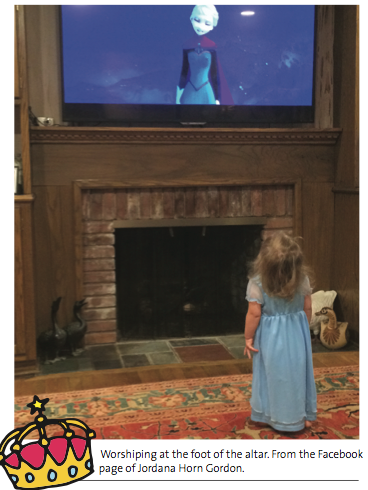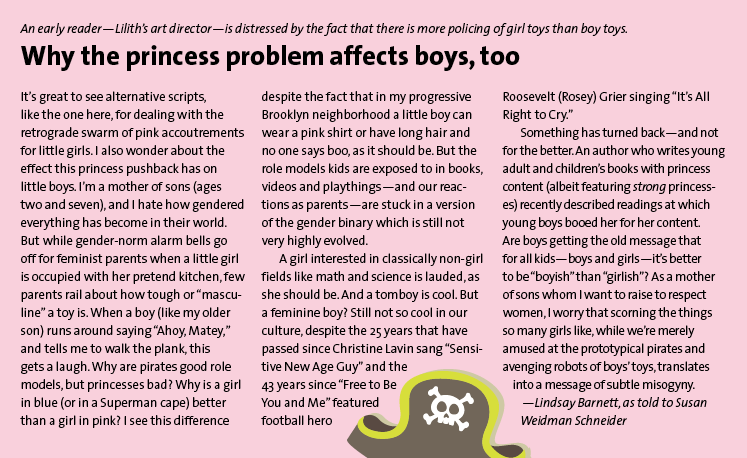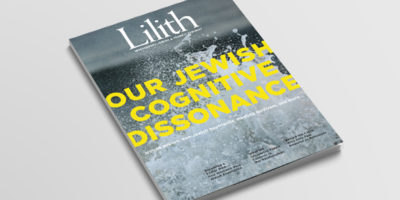
The Princess Problem
What’s a parent to do when faced with the burgeoning pink miasma enveloping little girls now? Bonus: a mom of boys worries too.
My name begins with E, a namesake of my grandmother Esther. So I’ve spent many a moment, like Jewish feminists before me, wrestling with the in-your-face dualities of the Book of Esther, one that places a would-be hero (and hidden Jew) in a harem of virgins for the king to peruse and use. And it’s not just any king. It’s Ahasuerus, most famous for banishing Vashti, the queen who refuses the king’s drunken command that she flaunt herself before his guests at a feast.
Esther’s story makes sublimating one’s identity an asset as it trumpets hidden power. Like many of the other takeaways from tales involving royalty, this is not what I want to instill in my daughter. Especially the bit about her family (Mordechai) encouraging her to sacrifice herself and marry this particular king. And yet, here’s a mighty woman who risks her life to derail a genocide scheme (Haman’s). It’s complicated. And it’s not just any woman. It’s Esther, a queen.
Lately, though, my mornings involve less big-picture reflection and more domestic strategizing. How, for example, can I weave my first cup of coffee into the pretend empire of my household queen, age 4.5, donning a crown (be it a gift, or a headband doing double duty) and a makeshift gown (scarf)?
So now I am yet another feminist parent of a yellow-bedroomed child who swore off gendered childhood (well, swore off reinforcing negative stereotypes) only to find herself walled off by a moat of princess adoration. And now that I’m here, I find it’s not what I expected. And that the question isn’t about whether we’ll face it, but how.
Two Halloweens ago, I asked my daughter if she wanted to dress up. She and her Dada conceived and created a homemade Super Grrrrl costume. Cape included. Last year, she said she’d like to be a queen. Sigh. For a long time after, I was patting myself on the back for what I said next: “You can be a queen, but queen of what?” That didn’t faze her: Queen of the Sea, she said. So, with her father’s help, that’s just what she was — their very own creation included a homemade cape and a seashell-studded crown. But after I said that looking great is nice, I declared, “it’s what you do that matters.” So, together, we figured out what exactly it means to be Queen of the Sea. I wasn’t surprised later when father and daughter decided together to make a Paperbag Princess costume for a school project.

A parenting rookie, I thought we’d dealt successfully with the princess/queen thing, which I’d been worried about handling, given the pink-panic warning bells I’d heard from feminist writers, among them Peggy Orenstein’s Cinderella Ate My Daughter: Dispatches from the Frontlines of the New Girlie-Girl Culture and, more recently, Sally Kohn’s endearing New York Times Motherlode essay, “Daughter to Disney: I’ll Take the Tiara, You Keep the Prince.” As Kohn put it: “I still can’t get decent reception on my cellphone but somehow traditional gender norms are silently communicated and crystal clear.”
Of course, like many children, these things are rarely put to bed so easily.
We are in the Strand Bookstore a few months ago, my daughter on a stool in the kids’ section at a short table where a dozen princess books she’s amassed stand neatly stacked. I sit down next to her on a too-small chair. Which one would you like me to read, I ask, reaching for the pile. No mama, she says. These are all princesses. You won’t like them or read them to me.
Aha. At age 4, she’d internalized my deep ambivalence, my dislike for Disney princesses. Although she couldn’t yet express it in words, she was already modifying her behavior based on her perceptions of my preferences, knowing I only accept princesses like “The Paperbag Princess” or “Cinder Edna” or the ones from Ethel Johnston Phelps’s international collection “Tatterhood and Other Tales” (get a copy for all the kids you know!) and that I won’t buy her a Frozen costume, even though just about every kid in her universe has one — boys and girls. She had internalized that I deem only feminist princesses acceptable, and that the other kinds are not welcome in our home. She has been learning from me that the things she loves are not okay for her to love.
Crap. That’s not how you raise an empowered daughter.
I’m a big believer in the importance of play and pretend, finding it reassuring somehow that so many studies find they build children’s creativity and confidence, particularly important when far too many girls have a confidence deficit that holds them back in life. I hate the concept of helicopter parenting. To my mind, bruised knees are badges of courage.
Yet here I was, helicopter feministing.
Sheesh. This was a huge mama moment for me. My job is to help her learn to navigate the world she lives in. Not to pretend it doesn’t exist or to shelter her from it. And I certainly never want her to feel she has to keep a part of her identity secret from me.
Oy.
As it turns out, my princess moat isn’t about choosing a side and standing firm. It’s about how to cross it. (Can’t go over it; can’t go under it; we’ll have to go through it.) So now I buy the occasional old-school princess toy or book. And when I read these stories to her, we talk about them when we’re done. Sometimes during. (“Mama, just read.”)
It’s true that I still try to steer her pretend play toward queens over princesses. After all, I grew up in the 1980s, and the last thing I want to do is revisit my own angst around the Jewish American Princess stereotype, past and present. We talk about real queens and princesses (my daughter is half Jewish New Yorker, half English, so there’s the Queen of England); plus, new practices of royal succession (less sexist!), and of course, how royals are different from presidents.
I tell her that queens have power, and I ask her — when she’s being a queen — how she’ll use hers.
All this thinking about princesses and queens leads me back to Esther, the ultimate story about pretending. Outside of Purim, in our particular cultural moment, Esther is nowhere near as ubiquitous as Elsa of “Frozen” fame, who reigns her own Disney Empire, and singlehandedly took down the myth that girl leads don’t sell. While my daughter delights in the G-rated version of Esther, the lessons of Elsa are much easier to distil and discuss with a young child: In “Frozen,” a girl has powers she struggles with, eventually embraces what scares her most, and emerges as an extremely powerful young woman. And while the whole Disney marriage thing plays its pronounced role, at least this princess is not in a harem.
A couple months after the bookstore incident, we are sleeping over at the house of friends in upstate New York. Excited about inner tubing the next morning, she can’t sleep. I don’t want to disturb anyone to go downstairs to fetch her own books and toys, so I dive into my own bag and pull out a book: Jill Lepore’s The Secret History of Wonder Woman. After all, it has pictures. She loves it. So much so that, weeks later, we’re still having a conversation about how I’m sharing it with her but it’s still mine. For now. Perhaps, though, when she’s just a little bit older, we’ll learn all about WW’s mysterious beginnings and delve deeper into why I prefer superheroes and action figures to princess dolls. And of them all, I like Wonder Woman best.
And somehow, buying pink dresses and mermaid sticker books seems less fraught now, in part because my husband is wearing a tiara while he makes breakfast and packs our girl’s lunch. And in part because my daughter pronounced, this very morning, about our living room: This is a Queendom, not a Kingdom. That’s all her. And this fall, thanks to Elsa and Esther and Wonder Woman, we’ll surely be talking more about hidden strengths, the difference between royals and presidents, titles and responsibilities — especially when I take her with me to vote.

Erica Brody is a writer, editor and strategist committed to progressive causes. She works in the places where culture and change intersect, most recently as executive director and editor in chief of Zeek Magazine.



